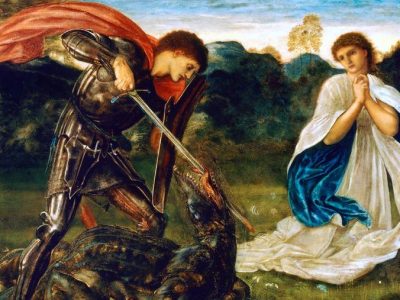St. George, the patron saint of England, is a figure steeped in legend and awe. While many people are familiar with the iconic image of St. George slaying a dragon, there is much more to his story. In this article, we will explore 10 fascinating facts about St. George that go beyond the popular myths and delve into his historical background. From his Greek origins to his martyrdom, these facts shed light on the man behind the legend.
1. Greek origins and early life
St. George, also known as Georgios, was likely of Greek descent. His parents were Greek Christians, and he was born in Cappadocia, a historical region that corresponds to modern-day Central Anatolia. Some accounts suggest that his father died for his faith when George was around 14 years old. After his mother’s death, George travelled to Nicomedia.
2. A soldier in the Roman army
In Nicomedia, George became a soldier in the Roman army, possibly serving in the prestigious Praetorian Guard. At the time, Christianity was still a minority religion, and Christians faced sporadic purges and persecutions. Despite the risks, George remained steadfast in his faith.
3. Martyrdom during the Diocletian Persecution
The most well-known account of St. George’s martyrdom is associated with the Diocletian Persecution, which occurred in the early 4th century AD. According to Greek hagiography, George was beheaded on the city wall of Nicomedia due to his refusal to renounce his Christian beliefs. The Empress Alexandra, wife of Emperor Diocletian, supposedly converted to Christianity after hearing of George’s suffering.
4. Different accounts of his martyrdom
While the Greek version of St. George’s martyrdom is widely accepted, there are variations in other accounts. According to Roman legend, George was tortured and killed by Dacian, the Emperor of the Persians. His martyrdom was prolonged, with over 20 instances of torture over seven years. In this version, George’s steadfast faith led to the conversion of over 40,000 pagans, including Empress Alexandra.
5. Canonisation as a Saint
St. George was officially canonised as a saint by Pope Gelasius in 494 AD. This declaration solidified his status as a revered figure within the Christian faith. The exact date of his canonisation is often associated with 23rd April, which is now celebrated as St. George’s feast day.
6. Patron Saint of England

St. George’s association with England began in the 12th century when the Crusaders adopted him as their patron saint. His popularity spread throughout Europe, and he eventually became the patron saint of England. St. George’s Day, celebrated on 23rd April, is a national holiday in England and is marked by various festivities and traditions.
7. Iconography and the legend of the dragon
The iconic image of St. George slaying a dragon has become synonymous with his name. This legend originated in medieval times and tells the story of a fearsome dragon terrorising a city. The city’s inhabitants offered it a daily human sacrifice to appease the dragon. When it was the princess’s turn to be sacrificed, St. George intervened, slaying the dragon and saving her life.
8. St. George and the Crusades
During the Crusades, St. George’s image was used to inspire and rally Christian soldiers. He was seen as a symbol of bravery, chivalry, and victory over evil. The Crusaders believed that invoking St. George’s name would grant them divine protection and aid in their battles against the Muslim forces.
9. International recognition
St. George’s veneration extends beyond England. He is recognised as a saint in various countries, including Georgia, Portugal, and Lebanon. In these countries, St. George is celebrated for his bravery and his role as a defender of the faith.
10. Modern interpretations and symbolism
Today, St. George continues to be a symbol of courage and righteousness. His image is often used in heraldry and can be found on national flags, coats of arms, and emblems. St. George’s Day is celebrated not only in England but also in countries and communities around the world that honour his legacy.
St. George’s story is a captivating blend of historical fact and mythological symbolism. St. George’s life has left a lasting impact on religious and cultural traditions, from his Greek origins and military service to his martyrdom and canonisation. Whether he is depicted as a dragon slayer or a courageous soldier, St. George continues to inspire and captivate the imagination of people worldwide.





